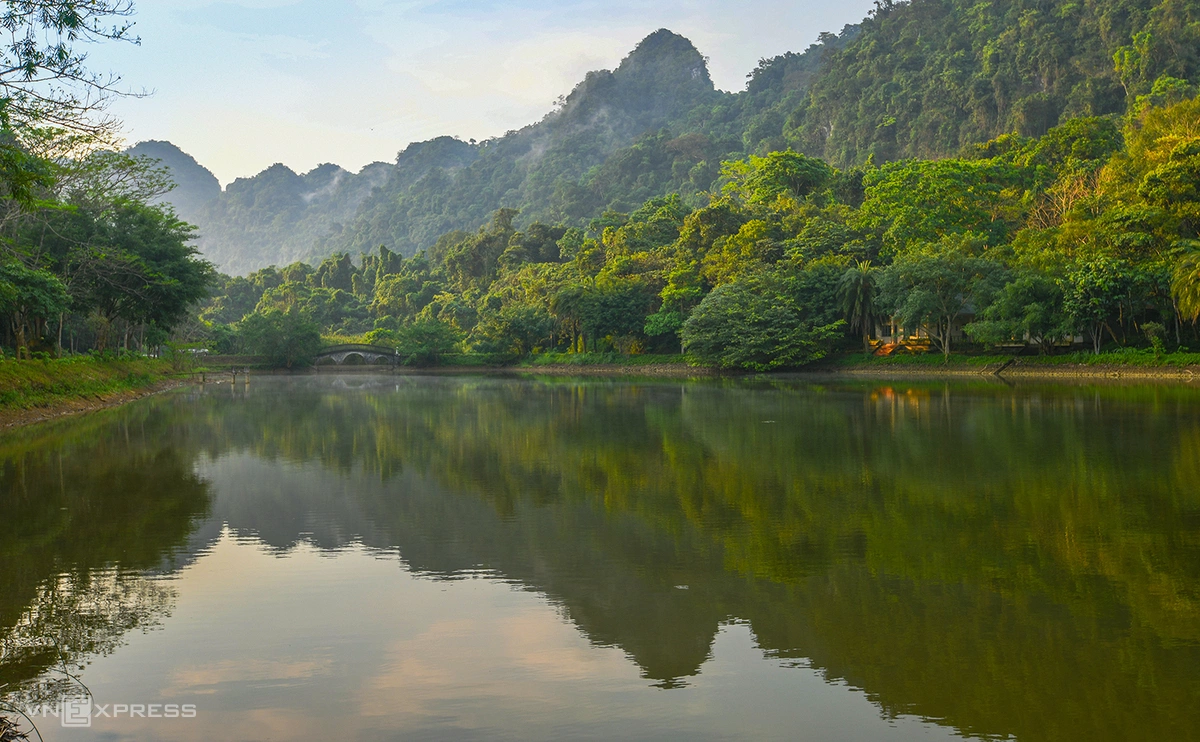
Northern Vietnam is a land where the echoes of history resonate in every corner, from the UNESCO-recognized Thang Long Imperial Citadel to the water puppet performances that have entertained generations.
The architecture reflects a blend of colonial and indigenous styles, telling stories of adaptation over centuries.
The people of northern Vietnam are as vibrant as the landscapes they inhabit. Warm and hospitable, they take pride in preserving their heritage through festivals and cuisine, with dishes like Hanoi’s bun cha or Hai Phong’s crab noodle soup.
Whether you’re exploring the streets of Hanoi or venturing into the wilderness, northern Vietnam leaves an impression, offering visitors not just a destination but an experience rich in culture and history.
Northern Vietnam experiences four distinct seasons, each with its own weather patterns. These changes not only shape the region’s beauty but also influence its cycles, festivals, and daily life.
Spring
Spring in northern Vietnam begins around the time of the Lunar New Year, typically in February to April. The weather becomes warm and pleasant, with average temperatures ranging from 20 to 21 degrees Celsius, making it ideal for agriculture. Spring is also a time of celebration, as many traditional and festivals take place during this period.
Summer
Summer starts around May and ends in August. This season is characterized by heatwaves, with temperatures often reaching 37 to 38 degrees Celsius. Despite the heat, summer is a season for the region, as it is the peak harvest time for fruits.
Autumn
Autumn, from September to November, is often regarded as the most beautiful season of the year in northern Vietnam. As the heat of summer fades, the weather becomes cooler and more comfortable, with occasional light showers.
Winter
Winter arrives around December, bringing a drop in temperatures. The average temperature ranges from 13 to 15 degrees Celsius, but in mountainous areas, the cold can intensify, sometimes leading to frost and even snowfall.
Getting to northern Vietnam is straightforward, thanks to its transportation network. Most international travelers arrive in Hanoi, the region's capital and main gateway, via Noi Bai International Airport. This airport serves international and domestic flights, making it a convenient starting point. Other international airport options are Cat Bi in Hai Phong City and Van Don near Ha Long Bay in Quang Ninh Province.
For those traveling from within Vietnam, domestic flights, trains, and buses offer multiple options. The railway system connects major cities to Hanoi, with sleeper trains providing a comfortable way to travel overnight. Long-distance buses are also available, linking northern Vietnam to other parts of the country.
If you’re already in Southeast Asia, overland travel is an option. Northern Vietnam shares borders with China and Laos, and there are international border crossings for those coming by bus or car.
Hanoi is a city where history, culture, and modern life intertwine. Its charm lies in its relics, architecture, bustling streets, and food scene. The best times to visit are in autumn (September to November) and spring (March to April), when the weather is mild and pleasant.

Thang Long Citadel is lit up at night. Photo by Pham Chieu
Visitors can explore landmarks like the Thang Long Imperial Citadel, a UNESCO World Heritage site where night tours feature ceremonies and dances. Another highlight is the Hoa Lo Prison Museum, which provides insights into Vietnam's wartime history and resilience.
For those seeking unique experiences, cycling tours to temples like Thang Long Tu Tran, visits to the West Lake area, and exploring the Ta Hien beer street are must-try activities. Cultural shows such as the Quintessence of Tonkin, held at Thay Pagoda, showcase Vietnam’s art forms and folklore.
Nature lovers can escape to Ba Vi National Park for camping and trekking, while food enthusiasts will enjoy Hanoi's iconic dishes like bun cha (grilled pork with noodles), cha ca (turmeric fish with dill), and banh tom (shrimp cakes).
Ninh Binh, 95 km from Hanoi, is renowned for its karst landscapes, ancient temples, and cultural heritage. The ideal time to explore Ninh Binh is from May to July, coinciding with the rice and lotus seasons.

Tam Coc-Bich Dong is a karst landscape where visitors can enjoy boat tours through golden rice paddies along the Ngo Dong River. The tour costs VND120,000 ($5) for entry and VND150,000 for a boat ride. Highlights include the Bich Dong Pagoda and the Hang Mua (Dancing Cave), offering panoramic views after a 500-step climb.
The Bai Dinh Pagoda complex, featuring Vietnamese architecture and a massive gold-plated Buddha statue, is another must-see. Electric shuttles make exploring the site easier. For nature enthusiasts, Cuc Phuong National Park offers trekking, wildlife tours, and kayaking, while the Van Long Nature Reserve provides boat rides through caves and wetlands.
Ninh Binh is famous for its goat meat, eel vermicelli, and crispy rice crackers (com chay).
Ha Giang Province, 300 kilometers from Hanoi, offers a cultural and natural experience with its rugged landscapes and ethnic diversity.

The ideal time to visit is between September and November when the weather is cool and dry. This period features rice terraces and buckwheat flowers.
Key attractions include the Dong Van Old Quarter, known for its Chinese-style architecture and flea markets; the Hmong King’s Palace, showcasing Qing Dynasty-inspired designs; and the Lung Cu Flag Tower, a symbol of national pride. Adventurers can traverse the Ma Pi Leng Pass or take a boat ride on the Nho Que River.
Ha Giang’s cuisine reflects its ethnic diversity, featuring dishes like five-colored sticky rice, buckwheat cakes, and Hmong-style black chicken hotpot. Signature meals such as thang den (sticky rice cake) and banh cuon (rice rolls) are must-tries.
Ha Long Bay, a UNESCO World Heritage site, is known for its limestone karsts and emeralds, making it one of Vietnam's most iconic destinations.

It is best visited from March to April or September to November, offering cool weather and ideal cruise conditions. The summer months of June to August also attract visitors with sunny days, though occasional storms may occur.
A cruise is the perfect way to experience Ha Long Bay's limestone karsts and islands. Options range from luxury overnight cruises with kayaking, cave tours, and cooking classes to budget-friendly day trips. Popular attractions include Sung Sot Cave, Thien Cung Grotto, and the Ti Top Islet. For adventurers, seaplane tours provide aerial views of the bay.
Signature dishes include bun be be (mantis shrimp noodles) and squid fritters (cha muc) served with rice rolls. For dessert, try local yogurt with tapioca balls.
Lao Cai Province is famed for its mountains, ethnic diversity, and cultural heritage. Just 300 kilometers from Hanoi, it borders Yunnan, China, and includes popular destinations like Lao Cai City, Sa Pa, and Fansipan Peak.

Sa Pa enchants with terraced fields, villages, and landmarks like Fansipan Peak, reachable by trekking or cable car. The O Quy Ho Pass offers mountain views, while Bat Xat District and Y Ty Commune are perfect for cloud hunting and scenic rice terraces. Bac Ha District is known for its colorful markets, Hoang A Tuong Mansion, and unique brocade crafts.
Lao Cai's culinary offerings feature pink pho, made from local brown rice, and thang co, a stew made with horse meat and offal, alongside the five-colored sticky rice. Visitors are also encouraged to sample regional specialties such as Ban Pho corn wine and Muong Khuong chili sauce.
Hai Phong, a northern port city, captivates visitors with its French Quarter, UNESCO-recognized biosphere reserves, beaches, caves, and cuisine. The ideal time to explore Hai Phong is from March to April and September to October, with mild weather perfect for sightseeing and outdoor activities.

Highlights include the colonial-era French Quarter with its Opera House, Kim Dong Park, and Hai Phong Museum. Nearby attractions such as Do Son Beach and the Cat Ba Archipelago offer natural beauty. Visitors can enjoy boat tours, kayaking in Lan Ha Bay, and trekking in Cat Ba National Park.
Hai Phong's culinary specialties include banh da cua (crab noodle soup), spicy breadsticks, crab spring rolls, and unique desserts like sui din (Chinese glutinous rice balls) and banh duc tau (a type of steamed rice cake). Food tours are a way to experience the city's rich flavors.
Located 200 kilometers from Hanoi, Moc Chau is known for its tea plantations, landscapes, and modern attractions like the Bach Long glass bridge, the world’s longest, spanning 630 meters over lush jungle valleys. November and December are ideal, with the plateau blanketed in white cauliflowers and yellow wild sunflowers, creating a stunning visual feast.

Visitors can trek to the 2,000-meter Pha Luong Peak, explore tea hills, or admire the Fairy Waterfall’s three cascades. The Hmong Village offers a glimpse into traditional life, while Ang Village's pine forest is perfect for camping.
Signature dishes include fried veal (be chao), grilled fish, and dried buffalo meat, a Black Thai specialty. Apart from tea, Moc Chau is also known for dairy farming and a good place to try cow milk, which is sold all over the country and even exported.
Mu Cang Chai, a northwest highland town, is famous for its terraced rice fields, local cuisine, and hot mineral springs.

The town shines during planting (May-June) and harvest seasons (September-October), with colorful landscapes that attract photographers and tourists. Visitors should prepare for hot days and chilly nights.
Highlights include paragliding over Khau Pha Pass, exploring Lim Mong Valley’s golden fields, and visiting the Mam Xoi and Mong Ngua Hills. Tourists can trek through a bamboo forest or zipline across Tu Le Valley. Tram Tau’s mineral hot springs and Tu Le’s green rice flakes are must-try experiences.
Local specialties include sticky rice, grilled black pork, wild bee pupae, salmon, and Tu Le’s green rice flakes, a perfect souvenir.